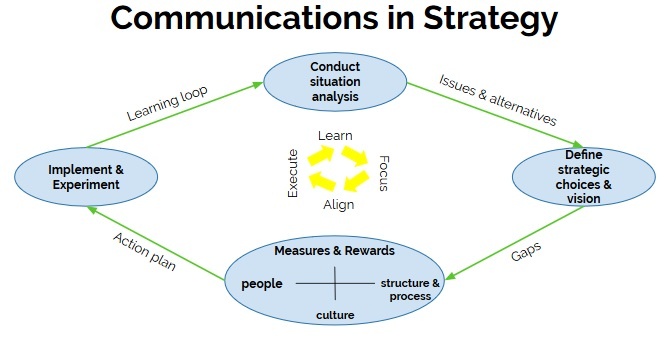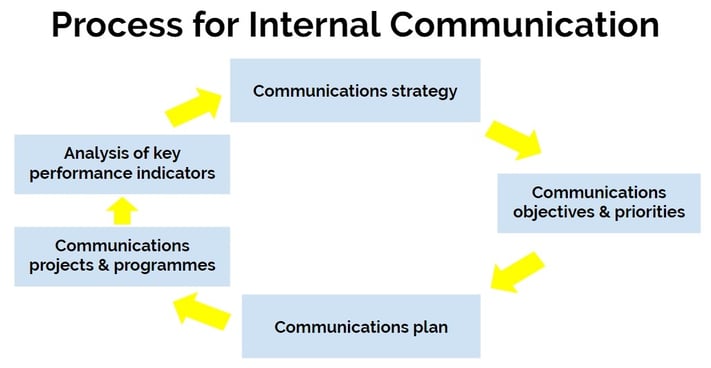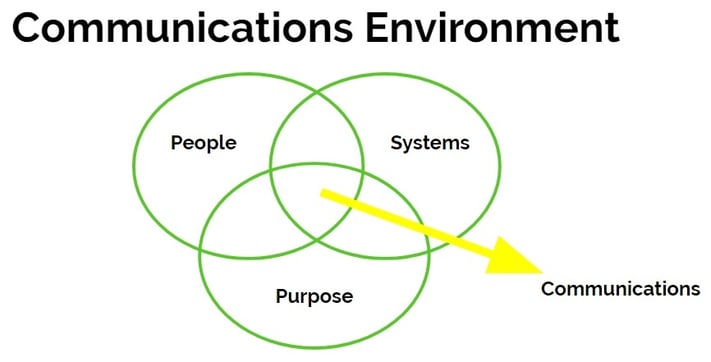
Last week, we covered the key principles for strategic internal communication.
I promised that I will be discussing how to create an internal communication strategy this week so here so let's do this!
An internal communication strategy sets out support and enables the delivery of the organisation's overall strategy. It converts the organisation's strategic intent into communications that support it and maximises the impact of an organisation's communications efforts.
In essence, the internal communication strategy
- aligns with the organisational strategy
- develops a set of communications plans and principles
- identifies key performance indicators and feedback mechanisms
Your international communication strategy must be unique to your organisation, its current situation, its unique strengths, weaknesses, opportunities and threats.
Which is why it's always important to start with an analysis of your surroundings before you begin crafting your international communication strategy.
7 Key Actions to Consider When Developing an Internal Communication Strategy:
- Talk to your leadership - What does senior management want from internal communication? What do they believe they are communicating at the moment? What are their communications capabilities and constraints? What's their vision for the organisation?
- Look at the external environment - What's operating in your external environments? What are the comms channels that are used? What are the influencers that operate there? E.g. very different in companies where they have more people with families than single people - families affect many decisions. Look at what's happening - if everyone is moving to Twitter, what can we learn from that? Who's doing something different? Is there something new? PEST, SWOT, Trends analysis are tools that can help you here.
- Look at the internal environment - What do people think about internal communication now? Does it allow them to do their jobs, do they understand the process, are there any difficulties for them? Who could be an extra resource for you that you may not be using now - e.g. middle managers, HR? What are your mechanisms and channels for receiving feedback and listening? Specifically look at what your weaknesses are in comms - Force Field Analysis is a great tool to use, also aligning with the next point.
- Examine the match or mismatch - What's the alignment between the internal and external environment? Is the current system working? If not or not perfect, what do we need to make it better? Is it the key messages and their impact, the channels and their relevance etc.?
- Identify what is your unique proposition - How do you turn the corporate strategy into a comms value or comms proposition? How do you demonstrate that - how does your external mission align with what you do internally for staff?
- Look to see how to maximise benefit from the above learnings - form a particular view from the above research on what should guide your internal communication strategy and make sure to maximise the opportunities and strengths.
Remember that communication must have 5 key competencies in place:
- insight - complex world needs understanding
- focus - on the right things
- alignment - all elements in with strategic focus
- execution - speed in turning strategic vision into realities, otherwise people will put their own frame of reference
- renewal - redo the above over and over; quicker and quicker

How to Build an Internal Communication Strategy in 8 Steps
Step 1: Situation analysis
- Examine the overall strategy and identity:
- Vision
- Values
- Take these to define key communication points as well as to turn them into communications vision and values where there is need that are distinct to those of the org but are in alignment.
As we've discussed, alignment with the overall strategy is a particularly important aspect. Your communication strategy should mirror the organisational one both in process and outcomes. If your company chooses to follow a low-cost strategy, then internal communication must not only reflect this but its activities fit with how the company wants to operate.
Step 2: Examine the environment in which you will communicate
- Look at how you communicate at present.
- Examine trends internally and externally.
- Research inside and outside the organisation.
- Use tools to explore your communications (focus groups, surveys etc.).
- Establish your audiences/stakeholders.
- Use devil's advocate/comparisons to explore your assumptions.
Here you are trying to identify any potential issues that might impact your ability to achieve your strategic intent through communication.
Step 3: Establish communications principles or ground rules
- Set the communications standards that people can expect - those could include standards for how you communicate with colleagues, how staff communicates with execs and vice versa, how you run meetings as well as things like style guides, tone of voice, templates and frameworks etc.
- Test new communications initiatives against these.
This is a key element of communication strategy, fundamental to building trust in an organisation. The principles allow putting order and consistency in all diverse communications activities.
Step 4: Set objectives for your communication strategy
- Set objectives (medium to long-term) that you can measure performance against.
- Will be broader but should be possible to make specific in communications plan (SMART).
Step 5: Define who you are going to be communicating with
- Define or redefine your target audience through research.
- Segment according to communication needs, not convenience.
- May need to develop new channels to meet new communications needs.
This is a key step that will allow you to decide who you need to communicate with and what messages you need to deliver. Your segmentation decisions need to be based on your objectives.
Step 6: Develop core messages
- Create messages that are general for all stakeholders across the organisation and communicate the company's why - the organisation's super-ordinate goal.
- "We will destroy Honda" by Yamaha - BHAG (Big Hairy Audacious Goal)
- "The customer above all else" - core value
- "To make people happy" - core purpose (Walt Disney)
- Define other messages that need to be specific for certain locations, groups, departments etc. but they all should be based on what the listener wants and needs to hear rather than what you think you should communicate. These messages should also support the main organisational message around its goal.
The core messages define what the organisation is and what it wants to achieve. All other messages support this and become relevant for specific audiences.
Step 7: Put a measurement plan in place
- Define key performance indicators in alignment with your objectives.
- Ask "What will be different is the strategy is operating successfully?"
- Use quantitative and qualitative tools for your communication audits - often, you will need to rely on focus groups, interviews, surveys and observation.
- Analyse what the outcomes of your communications are - did you change attitudes and the degree to which staff have internalised the messages?
It's essential that you build measurement into your communications strategy because what gets measured gets done. Your communications strategy should refer to how you will measure its implementation and success. Your measurement plan should be an objective in itself because it creates credibility to communications - these are the things we measure and this is how we performed; so much is invested in it, this is the return. In essence, measurement gives strategy meaning.
Step 8: Build in feedback
- Create open communications channels that encourage constant feedback.
- Keep studying the internal and external environments for major changes.
Your strategy should include a review mechanism that gives the opportunity to adjust or change your strategy in light of feedback that you receive from your stakeholders or after major changes in the organisation's business environment.
Communication is a two-way process - listening is the key to communication - you need to understand how people interpret and understand the strategy and if people misunderstand it, you need to find what you're doing wrong in your comms.

What other tips do you have for creating an internal communication strategy?








